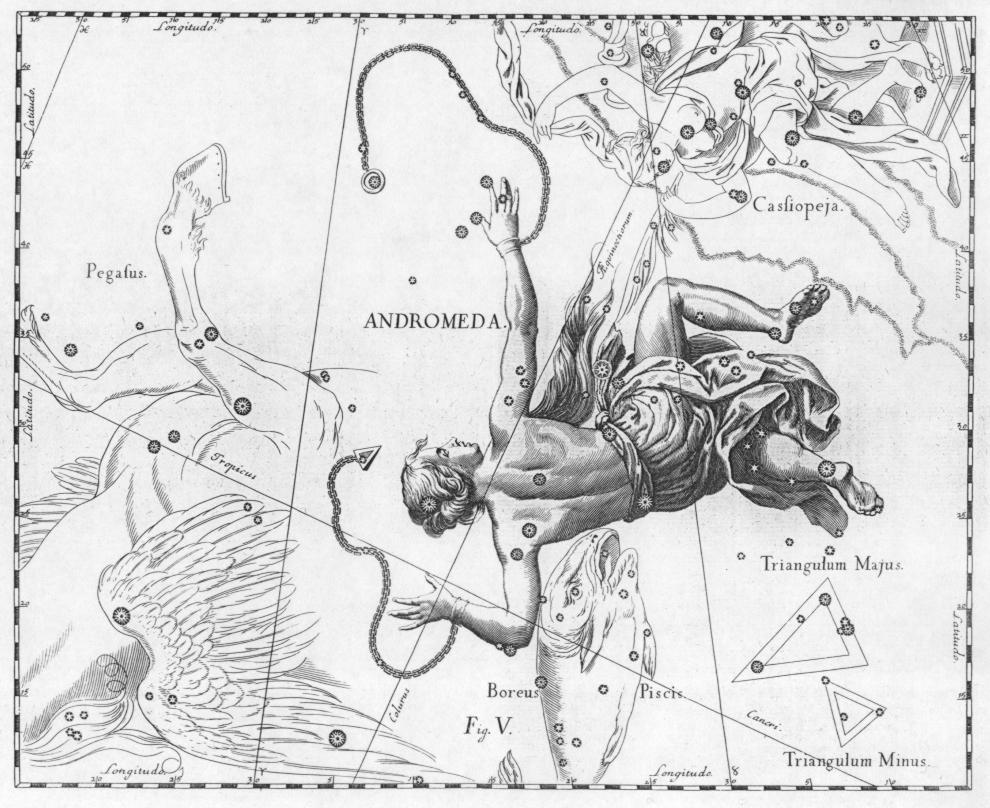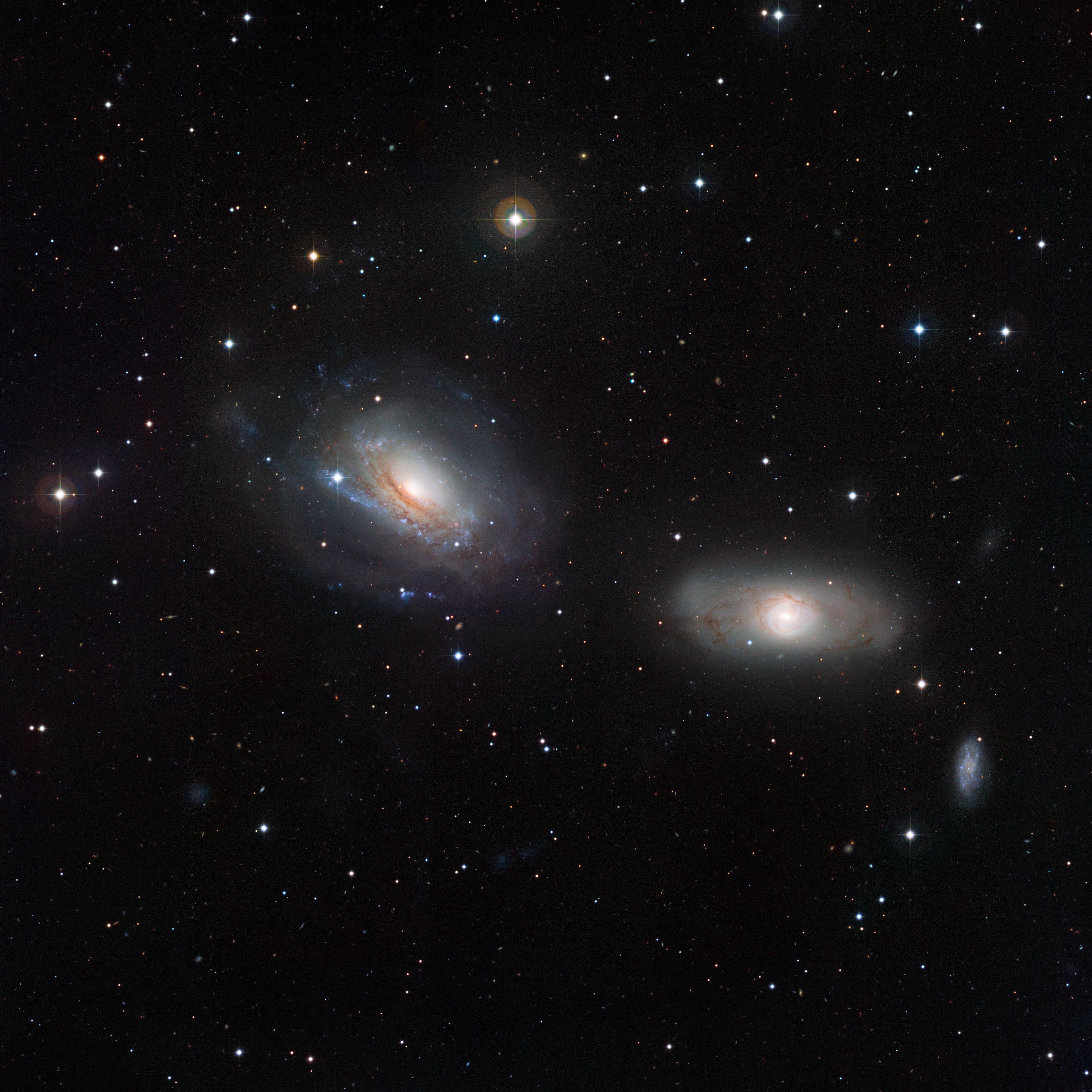|
Andromeda XIX
Andromeda XIX is a satellite galaxy of the Andromeda Galaxy (M31), a member of the Local Group, like the Milky Way Galaxy. Andromeda XIX is considered "the most extended dwarf galaxy known in the Local Group", and has been shown to have a half-light radius of 1.7 kiloparsec (kpc). It was discovered by the Canada–France–Hawaii Telescope, and is thought to be a dwarf galaxy. As with other dwarf galaxies, Andromeda XIX is not producing new stars: 90% of its star formation occurred over 9 billion years ago. However, compared to dwarf galaxies of similar mass Andromeda XIX is extremely diffuse, like Antlia II. History Surveillance performed during use of the MegaPrime/MegaCam 1 deg2 (camera) on the Canada-France-Hawaii Telescope (CFHT) had mapped the Andromeda Galaxy's stellar halo (one quarter) up to ~150 kpc. The survey, which had confirmed the clumpiness of Andromeda's stellar halo, had shown the existence of multiple other dwarf galaxies. They include: Andromeda XI, XII, ... [...More Info...] [...Related Items...] OR: [Wikipedia] [Google] [Baidu] |
Andromeda (constellation)
Andromeda is one of the 48 constellations listed by the 2nd-century Greco-Roman astronomer Ptolemy, and one of the 88 modern constellations. Located in the northern celestial hemisphere, it is named for Andromeda, daughter of Cassiopeia, in the Greek myth, who was chained to a rock to be eaten by the sea monster Cetus. Andromeda is most prominent during autumn evenings in the Northern Hemisphere, along with several other constellations named for characters in the Perseus myth. Because of its northern declination, Andromeda is visible only north of 40° south latitude; for observers farther south, it lies below the horizon. It is one of the largest constellations, with an area of 722 square degrees. This is over 1,400 times the size of the full moon, 55% of the size of the largest constellation, Hydra, and over 10 times the size of the smallest constellation, Crux. Its brightest star, Alpha Andromedae, is a binary star that has also been counted as a part of Pegasu ... [...More Info...] [...Related Items...] OR: [Wikipedia] [Google] [Baidu] |
Canada–France–Hawaii Telescope
The Canada–France–Hawaii Telescope (CFHT) is located near the summit of Mauna Kea mountain on Hawaii's Big Island at an altitude of 4,204 meters (13,793 feet), part of the Mauna Kea Observatory. Operational since 1979, the telescope is a Prime Focus/Cassegrain configuration with a usable aperture diameter of . CFHT currently planning a refurbishment to the facility in the 2020s. The facility will be reconstructed with a new 11-m telescope to produce the Maunakea Spectroscopic Explorer, retaining the same base building and infrastructure. First light is expected in 2029. Funding The corporation is bound by a tripartite agreement between the University of Hawaii at Manoa, in the United States, the National Research Council (NRC) in Canada and the Centre National de la Recherche Scientifique (CNRS) in France. CFHT also has partnerships with the National Astronomical Observatory of China (NAOC), the Academia Sinica Institute of Astronomy and Astrophysics (ASIAA) in Taiwan, the ... [...More Info...] [...Related Items...] OR: [Wikipedia] [Google] [Baidu] |
Interacting Galaxies
Interacting galaxies (''colliding galaxies'') are galaxies whose gravitational fields result in a disturbance of one another. An example of a minor interaction is a satellite galaxy disturbing the primary galaxy's spiral arms. An example of a major interaction is a galactic collision, which may lead to a galaxy merger. Satellite interaction A giant galaxy interacting with its satellites is common. A satellite's gravity could attract one of the primary's spiral arms. Alternatively, the secondary satellite can dive into the primary galaxy, as in the Sagittarius Dwarf Elliptical Galaxy diving into the Milky Way. That can possibly trigger a small amount of star formation. Such orphaned clusters of stars were sometimes referred to as "blue blobs" before they were recognized as stars. Galaxy collision Colliding galaxies are common during galaxy evolution. The extremely tenuous distribution of matter in galaxies means these are not collisions in the traditional sense of the word ... [...More Info...] [...Related Items...] OR: [Wikipedia] [Google] [Baidu] |
Dwarf Galaxies
A dwarf galaxy is a small galaxy composed of about 1000 up to several billion stars, as compared to the Milky Way's 200–400 billion stars. The Large Magellanic Cloud, which closely orbits the Milky Way and contains over 30 billion stars, is sometimes classified as a dwarf galaxy; others consider it a full-fledged galaxy. Dwarf galaxies' formation and activity are thought to be heavily influenced by interactions with larger galaxies. Astronomers identify numerous types of dwarf galaxies, based on their shape and composition. Formation One theory states that most galaxies, including dwarf galaxies, form in association with dark matter, or from gas that contains metals. However, NASA's Galaxy Evolution Explorer space probe identified new dwarf galaxies forming out of gases with low metallicity. These galaxies were located in the Leo Ring, a cloud of hydrogen and helium around two massive galaxies in the constellation Leo. Because of their small size, dwarf galaxies have bee ... [...More Info...] [...Related Items...] OR: [Wikipedia] [Google] [Baidu] |
List Of Andromeda's Satellite Galaxies
The Andromeda Galaxy (M31) has satellite galaxies just like the Milky Way. Orbiting M31 are at least 13 dwarf galaxies: the brightest and largest is M110, which can be seen with a basic telescope. The second-brightest and closest one to M31 is M32. The other galaxies are fainter, and were mostly discovered only starting from the 1970s. On January 11, 2006, it was announced that Andromeda Galaxy's faint companion galaxies lie on or close to a single plane running through the Andromeda Galaxy's center. This unexpected distribution is not obviously understood in the context of current models for galaxy formation. The plane of satellite galaxies points toward a nearby group of galaxies (M81 Group), possibly tracing the large-scale distribution of dark matter. It is unknown whether the Triangulum Galaxy is a satellite of Andromeda. Table of known satellites Andromeda Galaxy's satellites are listed here by discovery (orbital distance is not known). Andromeda IV is not included in t ... [...More Info...] [...Related Items...] OR: [Wikipedia] [Google] [Baidu] |
Andromeda XVIII
Andromeda XVIII, discovered in 2008, is a dwarf spheroidal galaxy (has no rings, low luminosity, much dark matter, little gas or dust), which is a satellite of the Andromeda Galaxy (M31). It is one of the 14 known dwarf galaxies orbiting M31. It was announced in 2010 that the orbiting galaxies lie close to a plane running through M31's center. See also * List of Andromeda's satellite galaxies The Andromeda Galaxy (M31) has satellite galaxies just like the Milky Way. Orbiting M31 are at least 13 dwarf galaxies: the brightest and largest is M110, which can be seen with a basic telescope. The second-brightest and closest one to M31 is ... References Dwarf spheroidal galaxies Andromeda Subgroup Andromeda (constellation) {{Elliptical-galaxy-stub ... [...More Info...] [...Related Items...] OR: [Wikipedia] [Google] [Baidu] |
Andromeda XI
Andromeda XI (And 11) is a dwarf spheroidal galaxy about 2.6 million light-years away from the Sun in the constellation Andromeda. Discovered in 2006, And XI is a satellite galaxy of the Andromeda Galaxy (M31). See also * List of Andromeda's satellite galaxies The Andromeda Galaxy (M31) has satellite galaxies just like the Milky Way. Orbiting M31 are at least 13 dwarf galaxies: the brightest and largest is M110, which can be seen with a basic telescope. The second-brightest and closest one to M31 is ... References {{DEFAULTSORT:Andromeda XI Andromeda (constellation) Dwarf spheroidal galaxies Astronomical objects discovered in 2006 Andromeda Subgroup Local Group ... [...More Info...] [...Related Items...] OR: [Wikipedia] [Google] [Baidu] |
Antlia II
Antlia II (Ant II) is a low-surface-brightness dwarf satellite galaxy of the Milky Way at a galactic latitude of 11.2°. It spans 1.26° in the sky just southeast of Epsilon Antliae. The galaxy is similar in size to the Large Magellanic Cloud, despite being 1/10,000 as bright. Antlia II has the lowest surface brightness of any galaxy discovered and is ~ 100 times more diffuse than any known ultra diffuse galaxy. The large size of the galaxy suggests that it is currently being tidally disrupted, and is in the process of becoming a stellar stream. The southeast side of Antlia II is farther away than the northwest side, likely due to the tidal disruption. It was discovered using data from the European Space Agency's ''Gaia'' spacecraft in November 2018. See also * Crater 2 Dwarf *Antlia Dwarf *Satellite galaxies of the Milky Way The Milky Way has several smaller galaxies gravitationally bound to it, as part of the Milky Way subgroup, which is part of the local galaxy cluster, the ... [...More Info...] [...Related Items...] OR: [Wikipedia] [Google] [Baidu] |
Parsec
The parsec (symbol: pc) is a unit of length used to measure the large distances to astronomical objects outside the Solar System, approximately equal to or (au), i.e. . The parsec unit is obtained by the use of parallax and trigonometry, and is defined as the distance at which 1 au subtends an angle of one arcsecond ( of a degree). This corresponds to astronomical units, i.e. 1\, \mathrm = 1/\tan \left( \ \mathrm \right)\, \mathrm. The nearest star, Proxima Centauri, is about from the Sun. Most stars visible to the naked eye are within a few hundred parsecs of the Sun, with the most distant at a few thousand. The word ''parsec'' is a portmanteau of "parallax of one second" and was coined by the British astronomer Herbert Hall Turner in 1913 to make calculations of astronomical distances from only raw observational data easy for astronomers. Partly for this reason, it is the unit preferred in astronomy and astrophysics, though the light-year remains prominent in popula ... [...More Info...] [...Related Items...] OR: [Wikipedia] [Google] [Baidu] |
Radius
In classical geometry, a radius ( : radii) of a circle or sphere is any of the line segments from its center to its perimeter, and in more modern usage, it is also their length. The name comes from the latin ''radius'', meaning ray but also the spoke of a chariot wheel. as a function of axial position ../nowiki>" Spherical coordinates In a spherical coordinate system, the radius describes the distance of a point from a fixed origin. Its position if further defined by the polar angle measured between the radial direction and a fixed zenith direction, and the azimuth angle, the angle between the orthogonal projection of the radial direction on a reference plane that passes through the origin and is orthogonal to the zenith, and a fixed reference direction in that plane. See also *Bend radius *Filling radius in Riemannian geometry *Radius of convergence * Radius of convexity *Radius of curvature *Radius of gyration ''Radius of gyration'' or gyradius of a body about the axis of r ... [...More Info...] [...Related Items...] OR: [Wikipedia] [Google] [Baidu] |
Dwarf Galaxy
A dwarf galaxy is a small galaxy composed of about 1000 up to several billion stars, as compared to the Milky Way's 200–400 billion stars. The Large Magellanic Cloud, which closely orbits the Milky Way and contains over 30 billion stars, is sometimes classified as a dwarf galaxy; others consider it a full-fledged galaxy. Dwarf galaxies' formation and activity are thought to be heavily influenced by interactions with larger galaxies. Astronomers identify numerous types of dwarf galaxies, based on their shape and composition. Formation One theory states that most galaxies, including dwarf galaxies, form in association with dark matter, or from gas that contains metals. However, NASA's Galaxy Evolution Explorer space probe identified new dwarf galaxies forming out of gases with low metallicity. These galaxies were located in the Leo Ring, a cloud of hydrogen and helium around two massive galaxies in the constellation Leo. Because of their small size, dwarf galaxies hav ... [...More Info...] [...Related Items...] OR: [Wikipedia] [Google] [Baidu] |




